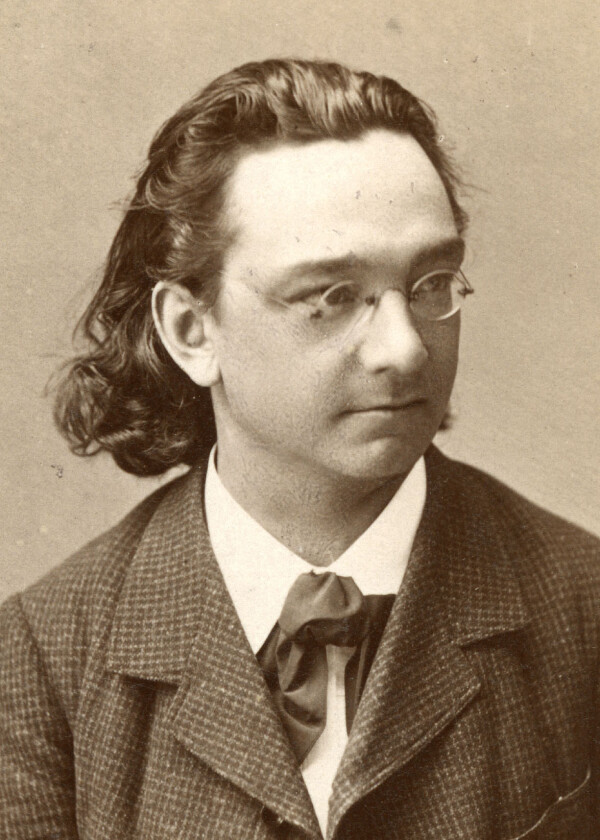Joseph Pembaur

© Brahms-Institut an der Musikhochschule Lübeck

Vienna branch of the "Spatenbräu" in the Zierer-Hof, 1895, Wien Museum
© Wien Museum
As a conductor, composer and music teacher and as the director of the Innsbruck Music Association, Joseph Pembaur enlivened the music scene in the capital of the Austrian state of Tyrol. Gustav Klimt created a portrait of him in 1890.
Joseph Pembaur sen. was born in Innsbruck on 23 May 1848 as the son of a civil servant and local council member. Pembaur initially studied law at the University of Innsbruck and later music in Vienna, where he for instance received composition and organ lessons from Anton Bruckner. He continued his organ studies in Munich and also studied music theory with Josef G. Rheinberger.
He returned to his hometown of Innsbruck in 1874, where he became the director of the local music association. Pembaur’s efforts resulted in a significant boost for Innsbruck’s music scene. In addition to conducting masses at the local Jesuit church and working for his own orchestral association, he acted as choirmaster of the Akademischer Gesangverein, the Innsbrucker Liedertafel as well as the Tiroler Sängerbund, which he had revived in 1881. The school of the music association, where he sometimes taught, was of special importance to Pembaur. Thanks to his efforts, the school achieved new renown and was able to move into a new building, which still houses the music conservatory of the city of Innsbruck today.
Even though Pembaur’s own works were composed in a late Romantic style, his concert programs betrayed his great interest in contemporary musical styles. His compositions enjoyed international acclaim. The work Deutsche Messe op. 62 (before 1897) was celebrated as one of his most important compositions and his works for male choirs were performed throughout Europe and America.
Joseph Pembaur died in Innsbruck on 19 February 1923. He was survived by three sons: Josef and Karl, who were also musicians, as well as Walter, who pursued a career in politics.
Klimt and the Pembaur Society
During the celebrations surrounding the performance of Pembaur’s work Bilder aus dem Leben Walthers von der Vogelweide in Bolzano in 1889, those present decided to found a Pembaur Society in honor of the composer. The attendees of the celebrations included Franz Matsch as well as Ernst and Gustav Klimt, who also joined the society.
In this context, Gustav Klimt created a portrait of Pembaur in 1890. The painting is one of Klimt’s rare male portraits. It was possibly commissioned by Georg Reimers – an actor at the Vienna Burgtheater and co-founder of the Pembaur Society – to be hung above the group’s usual table at the “Spatenbräu” tavern in Vienna (Neuer Markt 6, 1st District).

Gustav Klimt: Portrait of Joseph Pembaur, 1890, Tiroler Landesmuseum Ferdinandeum
© Scala Florence
The portrait shows a highly realistic half figure of Pembaur in a black suit in front of a monochrome background in vivid red. The photorealistic depiction suggests that Klimt may have painted the work from a photograph. It is well documented that Klimt frequently based his portraits on photographs in his early years. The inscription in an antique style and the dating in Roman figures testify to Klimt’s predilection for the use of historicizing image elements. The other motifs in the picture are also taken from Antiquity and inspired by templates from literature.
Klimt even decorated the golden frame with highly symbolic motifs, some of which hint at the identity of the portrayed subject. He integrated symbols taken from antique vases, such as a stylized sea, seven stars, several fish and Ionic columns as well as symbols of music such as a lyre and the deity Apollo. The initials of the “Spatenbräu” in Munich – where the actors and artists of the Pembaur Society met – reveals the intended purpose of the work.
Literature and sources
- Archiv der Universität Innsbruck, Sammlung Familie Pembaur.
- Wien Geschichte Wiki. Josef Pembaur. www.geschichtewiki.wien.gv.at/Josef_Pembaur_der_%C3%84ltere (04/26/2020).
- Österreichisches Musiklexikon online. Pembaur. www.musiklexikon.ac.at/ml/musik_P/Pembaur_Familie.xml (04/26/2020).
- Österreichisches Biographisches Lexikon. Pembaur. www.biographien.ac.at/oebl/oebl_P/Pembaur_Josef_1848_1923.xml;internal&action=hilite.action&Parameter=Pembaur* (04/26/2020).
- Art in Words. Josef Pembaur. artinwords.de/klimt-und-die-antike/klimt-josef-pembaur-1890/ (04/26/2020).
- N. N.: Das Walther-Denkmal in Bozen, in: Neuigkeits-Welt-Blatt, 17.09.1889, S. 4.
- Neues Wiener Tagblatt, 09.09.1910, S. 1-2.
- N. N.: M. K. (Max Kalbeck?): Reimers als Festredner, in: Neues Wiener Tagblatt, 09.09.1910.
- Georg Reimers: Burgtheater-Stammtische, in: Die Bühne. Wochenschrift für Theater, Film, Mode, Kunst, Gesellschaft, Sport, 3. Jg., Heft 72 (1926), S. 9-10.
- Herbert Giese: Franz von Matsch – Leben und Werk. 1861–1942. Dissertation, Vienna 1976, S. 287-288.

